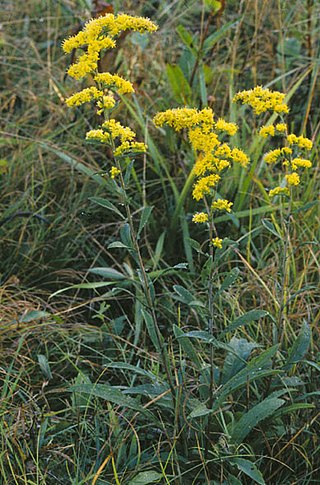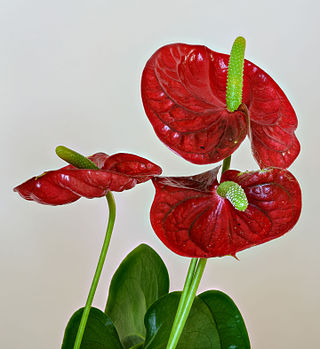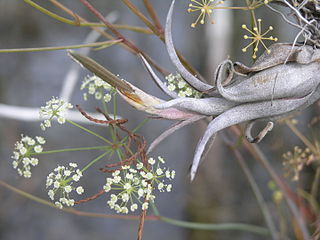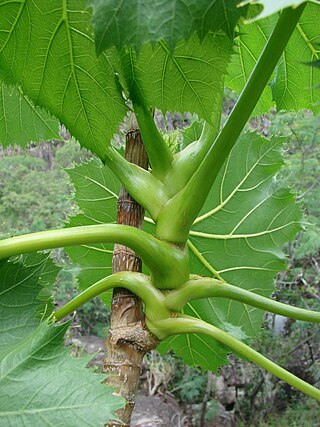
Apiaceae or Umbelliferae is a family of mostly aromatic flowering plants named after the type genus Apium and commonly known as the celery, carrot or parsley family, or simply as umbellifers. It is the 16th-largest family of flowering plants, with more than 3,800 species in about 446 genera, including such well-known and economically important plants as ajwain, angelica, anise, asafoetida, caraway, carrot, celery, chervil, coriander, cumin, dill, fennel, lovage, cow parsley, parsley, parsnip and sea holly, as well as silphium, a plant whose identity is unclear and which may be extinct.

Trillium is a genus of about fifty flowering plant species in the family Melanthiaceae. Trillium species are native to temperate regions of North America and Asia, with the greatest diversity of species found in the southern Appalachian Mountains in the southeastern United States.

Goldenrod is a common name for many species of flowering plants in the sunflower family, Asteraceae, commonly in reference to the genus Solidago.

Oenanthe, known as water dropworts, oenanthes, water parsleys, and water celeries, are a genus of plants in the family Apiaceae. Most of the species grow in damp ground, such as in marshes or in water.

Clintonia is a genus of flowering plants in the lily family Liliaceae. Plants of the genus are distributed across the temperate regions of North America and eastern Asia, in the mesic understory of deciduous or coniferous forests. The genus, first described by Constantine Samuel Rafinesque in 1818, was named for DeWitt Clinton (1769–1828), a naturalist and politician from the U.S. state of New York. For this reason, plants of the genus are commonly known as Clinton's lily. The common name bluebead refer to the distinctive fruit of members of the genus. Since fruit color varies somewhat across species, the common name bead lily is used as well.

Nasturtium is a genus of a small number of plant species in the family Brassicaceae commonly known as watercress or yellowcress. The best known species are the edible Nasturtium officinale and Nasturtium microphyllum. Nasturtium was previously synonymised with Rorippa, but molecular evidence supports its maintenance as a distinct genus more closely related to Cardamine than to Rorippasensu stricto.

Harperella is a monotypic genus of flowering plants in the family Apiaceae. Its only species is Harperella nodosa, known as piedmont mock bishopweed and harperella. It is native to riparian environments in the Southeastern United States, found at sites in West Virginia, Maryland, several Southeastern states such as Alabama and North Carolina, and the Ouachita National Forest in Arkansas and Oklahoma. As Ptilimnium nodosum, it was placed on the United States' Endangered Species List in 1988.

Anthurium is a genus of about 1,000 species of flowering plants, the largest genus of the arum family, Araceae. General common names include anthurium, tailflower, flamingo flower, and laceleaf.

Baptisia is a genus in the legume family, Fabaceae. They are flowering herbaceous perennial plants with pea-like flowers, followed by pods, which are sometimes inflated. They are native to woodland and grassland in eastern and southern North America. The species most commonly found in cultivation is B. australis.
Apodicarpum is a genus of flowering plants in the family Apiaceae. Its only species is Apodicarpum ikenoi. It is endemic to Japan.

Tiedemannia canbyi is a rare species of flowering plant in the carrot family known as Canby's dropwort and Canby's cowbane. It is native to the southeastern United States, where it occurs on the Atlantic coastal plain from North Carolina to Georgia, as well as the Chesapeake Bay area. It is threatened by the loss of the wetland habitat in which it grows. It is a federally listed endangered species of the United States.
Arisaema quinatum is a species of flowering plant in the arum family Araceae. It is a member of the Arisaema triphyllum complex, a group of closely-related taxa in eastern North America. The specific name quinatum means "divided into five lobes", a reference to its characteristic leaves. It is commonly known as the southern Jack-in-the-pulpit but some refer to it as Preacher John.

Oxypolis rigidior, known as cowbane, common water dropwort, stiff cowbane, or pig-potato, is a species of flowering plant in the carrot family native to eastern North America. It is a perennial wildflower found in wet habitats. Oxypolis rigidior is poisonous to mammals.

Tiedemannia filiformis is a species of flowering plant in the carrot family known by the common names water cowbane and water dropwort. It grows in swamps, freshwater wetlands, and along the borders of ponds in the southeastern United States, as far north as Delaware, as well as the northern Bahamian pineyards of the Bahamas.
Hypericum erythreae, the Georgia St. John's-wort, sparse-leaved St. John's-wort, or grit St. Johnswort, is a species of flowering plant in the St. John's wort family, Hypericaceae. It is native to the southeastern United States in seepage bogs and roadside ditches. Its name grit St. Johnswort comes from its limited distribution, within the Altamaha Grit region of the Georgia coastal plain.

Hypericum fasciculatum, known as peelbark St. Johnswort or sandweed, is a species of flowering plant in the St. Johnswort family, Hypericaceae, native to the southeastern United States. It is found from eastern North Carolina, south to southern Florida, west to eastern Louisiana. Kew's Plants of the World Online database also notes that it occurs in Cuba, though Cuba is not listed in several other sources. It was first described in 1797 by Jean-Baptiste Lamarck.

Oxypolis is a small genus of North American flowering plants in the carrot family known as cowbane, water dropwort, dropwort, hog-fennel, and pig-potato. As of 2020, Kew's Plants of the World Online accepts four species in the genus Oxypolis:

Klotzschia is a genus of flowering plants belonging to the family Apiaceae. It is native to Brazil.
Kozlovia is a genus of flowering plants belonging to the family Apiaceae.














